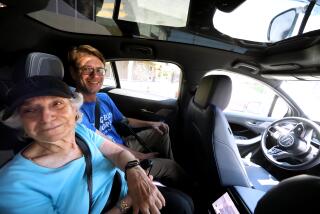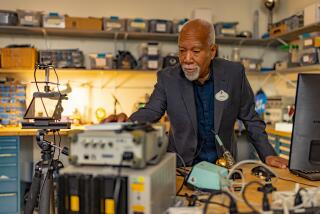But can that robot do windows?
LAS VEGAS — COMBINE the audio level of a mosh pit, the schmoozing of a political convention and the food service of a FEMA event, and what do you get? The annual Consumer Electronics Show -- the giant technology circus that this week invaded just about every convention venue and ballroom here with the latest TVs, appliances, robots and gadgets.
Amid the hoopla, numerous items on display promised to enhance home life. Many were at an event called “Digital Experience” at Caesars Palace. (“Turn left at the David statue,” directed a security guard.) Others were spread around 2 million square feet at the Las Vegas Convention Center. Some items were laughable, others sad. A precious few will be hits. Among the most noteworthy:
Starry Night: What comes with a $50,000 bed? This model from Leggett & Platt includes an HDTV projector that pops up from the headboard, as well as speakers, Internet connectivity, dual temperature controls for the mattress, massage, an iPod dock, and programmable music and lighting settings for reading, awakening or romance.
And that’s not all. A monitoring system can make a 911 call if one’s breathing stops, and a snoring sensor tilts up the head 7 degrees. “It opens the breathing passage,” said company executive Mark Quinn.
And if the snoring continues? “It goes up another 7 degrees,” Quinn said.
A discount version, without the entertainment package and some other niceties (but with the anti-snore bit) is $20,000.
What ever happened to Magic Fingers?
iRobot Looj gutter cleaner: That’s right, a robot gutter cleaner. Laugh if you like, but this gadget from the folks who produced the Roomba robotic vacuum was one of the hits of “Digital Experience.”
It looks like a slender version of a portable vacuum cleaner, with stiff brushes and plastic fins coming out of one end. It’s placed in a gutter clogged with leaves, mud and other gunk, then started with a remote controller that can be 100 feet away.
The little Looj goes back and forth in the gutter as the blades and fins blast out the yuk. (The demonstration used plastic leaves, but the device did seem powerful.)
And the inspiration for this product?
“One of our engineers actually saw his neighbor fall off a ladder while cleaning the gutters,” said iRobot spokeswoman Nancy Dussault Smith as she gathered leaves off the floor. At $99, the Looj is cheaper than a visit to the emergency room.
Whirlpool Centralpark Connection: Think of this as a $2,800 replacement for the kitchen magnet.
It’s a refrigerator with a built-in dock to accept a custom PC. The computer screen, which hangs on the front of the fridge door, can show a shopping list, little Sally’s soccer schedule, baby pictures and the like -- all the stuff folks have been putting on their refrigerators for years with magnets they got free from their optometrists.
The refrigerator costs $2,000 and the PC is $800. Extras are available for the dock, including a digital picture frame and an iPod speaker system.
The company said that eventually all of its refrigerators will be equipped with the docking system. Note to Whirlpool: Just don’t mess with the ol’ door ice dispenser.
Lightglove: At almost every CES, at least one vendor shows a hands-free technology for switching on lights, controlling the TV set, playing video games and more with just a wave of the hand.
At times, these demonstrations resembled a magic show gone bad. But this small Virginia company might have made true progress with its a hand-signal controller.
The device looks like a wristwatch so hefty it would make bling meister Jacob the Jeweler blush. To start the demonstration, company founder Bruce Howard twisted the device in the air a couple of times like a queen gesturing to her subjects, engaging the infrared technology.
Then he mimed playing a piano in the air, and his nearby laptop responded with Bach’s “Jesu, Joy of Man’s Desiring” (Howard didn’t have to be an expert pianist -- the software on the screen was from a Guitar Hero-type game that doesn’t require musicianship.)
He then played an on-screen pinball game, adding that the device could be programmed to do tasks around the house.
It’s not cheap. The wrist device, which is scheduled to hit the market in the spring, is priced at $400. Appliance controllers will come later.
Sounded a bit like a high-tech Clapper for people too lazy to clap. But, said Howard, “think about what this could do for elder care, for people who have trouble with a remote control or even dialing the phone.”
Clap on.
GPS dog finders: Not just one, but two products for finding a wandering Fido were on display at “Digital Experience.” Both featured small transmitters the size of a bar of hotel soap that fit on dog collars. They send signals to automated services that in turn notify owners if a pooch goes outside a yard.
Zoombak is priced at $199, plus $14.99 for the monthly monitoring service. PocketFinder costs $129.95, plus a monthly $12.95.
Isn’t that a bit steep, especially considering that the monitoring service is all electronic?
John Cullen of Zoombak had a ready answer.
“What would you pay to get your dog back?” he asked chillingly.
Now, there’s an old-fashioned salesman for a digital age.
--



